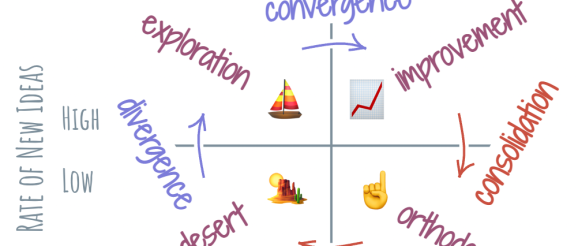Convergent innovation

As a sort of thought appetizer, here’s a vignette attempting to intersect the divergent/convergent thinking frame and … you guessed it, dandelions and elephants.
While exploring idea generation strategies, I realized that I’ve confused the opposite of divergent thinking with the lack of new ideas. That does not seem to be the case. There is a really simple 2×2 that helps illustrate that. Horizontally, we have dandelions and elephants, and vertically – the rate of new ideas that we want to encourage. Some organizations, for example, don’t want any new ideas altogether (low rate), while others have an existential need for new ideas (high rate).
The upper quadrants make sense: we have our dandelion-fueled exploration and improvements to existing ideas through the elephant strategy. The bottom-right quadrant shows up as orthodoxy – when new ideas are unwanted because we believe that there’s already one idea that is understood as well as it could be. The final, bottom-left quadrant is that of the idea desert: the absence of ideas altogether. This quadrant rarely has permanent occupants, because we humans tend to have ideas – however, we might occasionally visit it when we’re lost and disoriented.
If I were to explore how an organization might move from quadrant to quadrant, there appear to be four clockwise motions, from one quadrant to another. When our process of  exploration (the top-left quadrant) yields many interesting ideas, organizations tend to shift into the convergent posture: start looking for one idea that will become bigger than others. A typical call here is “more wood behind fewer arrows” and conversations about prioritization and hard decisions. Convergence leads to the top-right quadrant of
exploration (the top-left quadrant) yields many interesting ideas, organizations tend to shift into the convergent posture: start looking for one idea that will become bigger than others. A typical call here is “more wood behind fewer arrows” and conversations about prioritization and hard decisions. Convergence leads to the top-right quadrant of  improvements, where most of our efforts are invested into reinforcing the idea.
improvements, where most of our efforts are invested into reinforcing the idea.
Thinking in this quadrant does not need to be boring and uncreative. For example, one of my colleagues, upon joining our team, spent a bunch of time looking through the code and spotted a bug: in handling mouse events, we would sometimes hit an O(n2) condition – and that was unnecessary. Their first commit to the codebase was a performance breakthrough. When I think of innovation in the top-right quadrant, I keep recalling that bit of code. It was clearly a novel insight, yet it also demonstrably improved the state of the bigger idea.
Unfortunately, our residence in this quadrant usually comes to an end due to the consolidation move. In an effort to better protect the value contained within the big idea, organizations usually shift to the quadrant of  orthodoxy, where any new ideas are viewed as mostly distractions. There’s so much stuff to do already! The problem lists are long and the issues are well-known. Let’s just keep on fixing them, shall we?
orthodoxy, where any new ideas are viewed as mostly distractions. There’s so much stuff to do already! The problem lists are long and the issues are well-known. Let’s just keep on fixing them, shall we?
As you may suspect from the flow of this story, the discouraging of new ideas eventually triggers the next move: obsolescence. This move puts us into the  idea desert. We know that the old big idea no longer works, but we have nothing else to hang onto. The discomfort of this quadrant acts a powerful motivator, manifesting as the divergence move that propels us back into the
idea desert. We know that the old big idea no longer works, but we have nothing else to hang onto. The discomfort of this quadrant acts a powerful motivator, manifesting as the divergence move that propels us back into the  exploration quadrant. This move might coincide with the demise of the organization, when the divergence acts as a pulling-apart force of ideas, each stakeholder pursuing their own.
exploration quadrant. This move might coincide with the demise of the organization, when the divergence acts as a pulling-apart force of ideas, each stakeholder pursuing their own.
If we are to believe this tall tale, we can see that divergence and convergence are somewhat orthogonal moves. The divergence is mostly about moving from zero to many ideas while relying on dandelion strategies.
On the other hand, the convergence is a qualitative shift. It does not change how much idea-generation we do, but rather whether or not these ideas are independent from each other. A productive convergence is the one where people ideate while building on each other’s ideas, improving upon one unifying big idea – the elephant strategy.
This might not be news to you at all, but this was a pretty useful insight for me. When planning the next diverge/converge exercise:
- To get divergence truly going, put people in the idea desert. Let them have the sense that all of their previous, strongly-held beliefs might not be as sound and safe as they seem. This might mean not letting people prepare for the exercise or even creating an idea parking lot that is filled at the beginning with the ideas that we already have.
- Recognize the creative part of convergent thinking. Let people continue ideate, but shift the constraints of the exercise to encourage the clumping of ideas together. Avoid prematurely collapsing the process straight toward the orthodoxy.
Convergence doesn’t have to be a boring prioritize-and-cut procedure. It can be fun – and who knows, maybe produce new ideas that didn’t pop up during the divergence part of the exercise?
